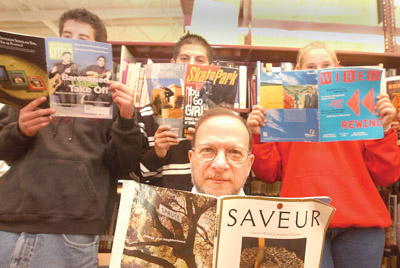
Arelene Gamboa, 16, had a blank look on her face when asked who
Paul Newman and Pete Rose were.
On the other hand, most teachers don’t know what
”
bling, bling
”
means or what Ctrl+Alt+Del refers to.
These are just a few of the cultural reference differences
between teachers and students that can cause confusion in the
classroom.
Arelene Gamboa, 16, had a blank look on her face when asked who Paul Newman and Pete Rose were.
On the other hand, most teachers don’t know what “bling, bling” means or what Ctrl+Alt+Del refers to.
These are just a few of the cultural reference differences between teachers and students that can cause confusion in the classroom.
For instance, one student used the phrase bling, bling in an English class and was told to leave after the classroom erupted in laughter, said Gamboa, a sophomore at San Benito High School.
“We had to explain to (the teacher) that it wasn’t a bad word,” Gamboa remembered.
Bling, bling refers to excessive or flashy jewelry and Ctrl+Alt+Del is a way of restarting a computer.
Another time, a teacher used the word yellow to describe someone. Gamboa and her classmates had no idea that yellow meant cowardly.
Bling, bling and Paul Newman made it on to Beloit College’s sixth annual Mindset List. The list attempts to bridge the gap so teachers can communicate better with students.
“Professors will teach by referring to cultural information for purposes of analogy or illustration. But the kind of information they’re using may simply not be relevant to (teenage) minds,” said Beloit College professor Tom McBride, a developer of the list.
Anzar High School Librarian Paul Stampleman said it’s incredible what today’s students are not familiar with.
“Every year, (the gap) gets more and more,” Stampleman said. “Wars are very different for them. To them, Vietnam is ancient history. They didn’t know about the (first) Gulf War. They said, ‘You mean there was a war before this one?’ Some don’t even know we landed a person on the moon. They’ve lived with the space station.”
While SBHS senior Anthony Pulliam didn’t know who Paul Newman or Pete Rose were either, he said he thinks teachers keep up with today’s trends.
“All the teachers seem really hip with the times. They don’t use the slang themselves,” Pulliam said.
Overall, slang is what most teachers have a problem keeping up with. SBHS teacher Dennis DeWall was just getting used to “bad” meaning good when students started using “sucks” to mean really bad, he said. DeWall said he’s used to the Fonz saying “cool” on “Happy Days” in the ’70s.
Teachers almost need a dictionary to understand students, Stampleman said.
Most of today’s phrases and references come from the media, especially TV and MTV. Today’s students are more informal than generations past, use a lot of curse words and talk about sex very openly, Stampleman and DeWall agreed.
“Curse words are used and tolerated much more in school and in general,” Stampleman said.
Because cultural change is so rapid these days, some people in their 20s might feel old hearing about the different phrases and words. That’s because marketers target students in a specific age range and what’s “new” turns over so often.
Still, adults are cautioned not to dismiss younger generations just because they have other references.
“They teach us almost as much as we teach them,” Stampleman said. “You have to be open to it.”
Free Lance wire services contributed to this story.









